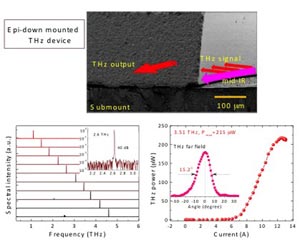Northwestern Researchers Develop Compact, High-Power Terahertz Source at Room Temperature

A breakthrough by Manijeh Razeghi and her partners triples the output power of a compact, room-temperature terahertz source.<br>
Terahertz (THz) radiation — radiation in the wavelength range of 30 to 300 microns — is gaining attention due to its applications in security screening, medical and industrial imaging, agricultural inspection, astronomical research, and other areas.
Traditional methods of generating terahertz radiation, however, usually involve large and expensive instruments, some of which also require cryogenic cooling. A compact terahertz source — similar to the laser diode found in a DVD player —operating at room temperature with high power has been a dream device in the terahertz community for decades.
Manijeh Razeghi, Walter P. Murphy Professor of Electrical Engineering and Computer Science at Northwestern University’s McCormick School of Engineering and Applied Science, and her group has brought this dream device closer to reality by developing a compact, room-temperature terahertz source with an output power of 215 microwatts.
Razeghi will present the research October 7 at the International Conference and Exhibition on Lasers, Optics & Photonics in San Antonio, and also at the European Cooperation in Science and Technology conference in Sheffield, England on October 10. The findings were published July 1 in the journal Applied Physics Letters and was presented at the SPIE Optics + Photonics conference in August in San Diego.
Razeghi’s group is a world leader in developing quantum cascade lasers (QCL), compact semiconductor lasers typically emitting in the mid-infrared spectrum (wavelength range of 3 to 16 microns).
Terahertz radiation is generated through nonlinear mixing of two mid-infrared wavelengths at 9.3 microns and 10.4 microns inside a single quantum cascade laser. By stacking two different QCL emitters in a single laser, the researchers created a monolithic nonlinear mixer to convert the mid-infrared signals into terahertz radiation, using a process called difference frequency generation. The size is similar to standard laser diode, and a wide spectral range has already been demonstrated (1 to 4.6 THz).
“Using a room-temperature mid-infrared laser to generate terahertz light bypasses the temperature barrier, and all we need to do is to make the output power high enough for practical applications,” said Razeghi, who leads Northwestern’s Center for Quantum Devices (CQD). “Most applications require a minimum of microwatt power levels, but, of course, the higher the better.”
The achieved output power, 215 microwatts, is more than three times higher than earlier demonstrations. This dramatic boost is due to a number of novelties, including Cherenkov phase matching, epilayer down mounting, symmetric current injection, and anti-reflection coating.
The researchers will now work to achieve continuous wave operation and incorporate tuning in the device.
This work is supported by National Science Foundation (NSF) and National Aeronautics Space Association (NASA).
Media Contact
More Information:
http://www.northwestern.eduAll latest news from the category: Physics and Astronomy
This area deals with the fundamental laws and building blocks of nature and how they interact, the properties and the behavior of matter, and research into space and time and their structures.
innovations-report provides in-depth reports and articles on subjects such as astrophysics, laser technologies, nuclear, quantum, particle and solid-state physics, nanotechnologies, planetary research and findings (Mars, Venus) and developments related to the Hubble Telescope.
Newest articles

Combatting disruptive ‘noise’ in quantum communication
In a significant milestone for quantum communication technology, an experiment has demonstrated how networks can be leveraged to combat disruptive ‘noise’ in quantum communications. The international effort led by researchers…

Stretchable quantum dot display
Intrinsically stretchable quantum dot-based light-emitting diodes achieved record-breaking performance. A team of South Korean scientists led by Professor KIM Dae-Hyeong of the Center for Nanoparticle Research within the Institute for…

Internet can achieve quantum speed with light saved as sound
Researchers at the University of Copenhagen’s Niels Bohr Institute have developed a new way to create quantum memory: A small drum can store data sent with light in its sonic…





















